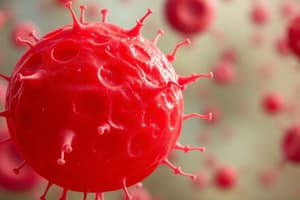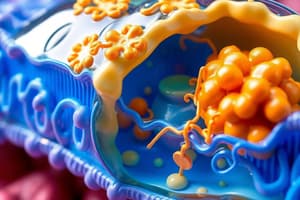Podcast
Questions and Answers
Which cellular structure is responsible for modifying proteins and packaging them for secretion from the cell?
Which cellular structure is responsible for modifying proteins and packaging them for secretion from the cell?
- Golgi Apparatus
- Mitochondria
- Lysosome
- Endoplasmic Reticulum (correct)
Cholesterol increases the rigidity of the cell membrane across all temperature ranges.
Cholesterol increases the rigidity of the cell membrane across all temperature ranges.
False (B)
What is the primary function of channel proteins in the cell membrane?
What is the primary function of channel proteins in the cell membrane?
creating pores for molecules to pass through
The process where cells take in nutrients or other substances by surrounding them is known as ________.
The process where cells take in nutrients or other substances by surrounding them is known as ________.
Match the following metabolic processes with their descriptions:
Match the following metabolic processes with their descriptions:
Which of the following best describes the role of carrier proteins in facilitated transport?
Which of the following best describes the role of carrier proteins in facilitated transport?
Exocrine glands release hormones directly into the bloodstream.
Exocrine glands release hormones directly into the bloodstream.
What is the role of nuclear pores in the context of the nucleus?
What is the role of nuclear pores in the context of the nucleus?
The internal scaffolding of protein fibers within the cytoplasm is called the ________.
The internal scaffolding of protein fibers within the cytoplasm is called the ________.
Match the following tissue types with their primary function:
Match the following tissue types with their primary function:
Which of the following cellular components is directly involved in cell recognition and immune response?
Which of the following cellular components is directly involved in cell recognition and immune response?
During anaerobic respiration, pyruvate enters the Krebs cycle to produce a large amount of ATP.
During anaerobic respiration, pyruvate enters the Krebs cycle to produce a large amount of ATP.
Name three factors that affect enzyme function.
Name three factors that affect enzyme function.
__________ are biological catalysts that lower the activation energy of reactions within cells.
__________ are biological catalysts that lower the activation energy of reactions within cells.
Which type of vesicular transport is responsible for moving substances out of the cell?
Which type of vesicular transport is responsible for moving substances out of the cell?
Flashcards
Cell Membrane
Cell Membrane
Supports the cell and separates the cytoplasm from the extracellular environment.
Integral Proteins
Integral Proteins
Interact with both the internal and external environment of the cell membrane.
Channel Protein
Channel Protein
Creates pores that allow specific molecules to pass through the cell membrane.
Carrier Protein
Carrier Protein
Signup and view all the flashcards
Cholesterol (in cell membrane)
Cholesterol (in cell membrane)
Signup and view all the flashcards
Glycoprotein
Glycoprotein
Signup and view all the flashcards
Cytoskeleton
Cytoskeleton
Signup and view all the flashcards
Endoplasmic Reticulum (ER)
Endoplasmic Reticulum (ER)
Signup and view all the flashcards
Nucleus
Nucleus
Signup and view all the flashcards
Facilitated Transport
Facilitated Transport
Signup and view all the flashcards
Carrier-Mediated Transport
Carrier-Mediated Transport
Signup and view all the flashcards
Vesicular Transport
Vesicular Transport
Signup and view all the flashcards
Endocytosis
Endocytosis
Signup and view all the flashcards
Exocytosis
Exocytosis
Signup and view all the flashcards
Metabolism
Metabolism
Signup and view all the flashcards
Study Notes
- The cell membrane supports the cell and separates the cytoplasm from the extracellular fluid.
Integral Proteins
-
Interact with both the internal and external environments of the cell.
-
Channel proteins create pores for molecules to pass through the membrane.
-
Carrier proteins transport specific molecules across the membrane by changing shape.
-
Cholesterol maintains membrane stability by preventing it from becoming too rigid or fluid and helps regulate permeability.
-
Glycoproteins are involved in cell recognition, communication, and immune responses.
-
The cytoskeleton is an internal scaffolding of protein fibers within the cytoplasm.
-
The endoplasmic reticulum (ER) is a pair of parallel membranes that form a network of channels.
-
The ER modifies proteins and packages them for secretion and produces transport vesicles.
-
The nucleus controls cellular activity.
-
Nuclear pores allow molecules like RNA to move in and out of the nucleus.
-
Connective tissue binds and supports other tissues in the body.
-
Muscular tissue cells are long and thin, known as muscle fibers.
-
Epithelial tissue lines and covers body cavities and ducts.
Glandular Epithelial Tissue
- Exocrine glands release hormones directly into the bloodstream.
- Endocrine glands release substances through ducts onto surfaces or into cavities.
Facilitated Transport
- Molecules move across the cell membrane via special proteins.
- Carrier-mediated transport uses specific carrier proteins that bind to molecules and help them move across the membrane.
Vesicular Transport
- Transports large molecules that can't pass through other forms of transport.
- Endocytosis brings substances into the cell.
- Exocytosis moves substances out of the cell.
- Pinocytosis, a type of exocytosis, is used by cells to take in nutrients or other substances from the surrounding environment.
Metabolism
- Chemical processes occur within a living organism to maintain life.
- Catabolism is the breakdown of organic molecules into smaller molecules, releasing energy (e.g., digestion).
- Anabolism involves smaller organic molecules combining to form larger organic molecules, requiring energy (e.g., amino acids joining to make dipeptides).
Nutrients
- Carbohydrates (e.g., glucose) are the primary source of quick energy in cells.
- Glucose undergoes glycolysis and aerobic respiration to produce ATP.
- Proteins provide amino acids for protein synthesis, tissue repair, and enzyme function.
- Some amino acids can be used in gluconeogenesis for energy production.
- Lipids (fats) are a key source of long-term energy storage.
- Fatty acids are broken down into acetyl-CoA and enter the Krebs cycle to produce ATP.
- Vitamins and minerals act as coenzymes and co-factors in various metabolic reactions.
- Vitamin B (like B6 and B12) is crucial in energy metabolism.
- Minerals like iron are involved in oxygen transport and ATP production.
- Enzymes are biological catalysts that change the rate of reaction and lower activation energy in cells.
Factors Affecting Enzyme Function
- pH: Enzymes have an optimal pH range; deviations can denature the enzyme.
- Temperature: High temperatures speed up reactions but can denature enzymes; low temperatures slow enzyme activity.
- Inhibitors: Competitive inhibitors block the active site, slowing reactions; non-competitive inhibitors change the enzyme's shape, preventing substrate binding.
- Coenzymes and cofactors assist enzymes by helping bind substrates or participate in reactions.
- Coenzymes are organic (e.g., NAD+), while cofactors are often metal ions (e.g., zinc, iron).
- Reactant/Product Concentrations: High reactant concentration speeds up the reaction; high product concentration can slow or reverse the reaction.
Aerobic vs. Anaerobic
- Both are processes of breaking down glucose to produce ATP, with aerobic respiration using oxygen.
Anaerobic Process
- After glycolysis, pyruvate is converted into lactic acid (in animals) or ethanol and carbon dioxide (in yeast and some bacteria) through fermentation.
- This regenerates NAD+, necessary for glycolysis to continue, producing a small amount of ATP without oxygen.
Studying That Suits You
Use AI to generate personalized quizzes and flashcards to suit your learning preferences.




